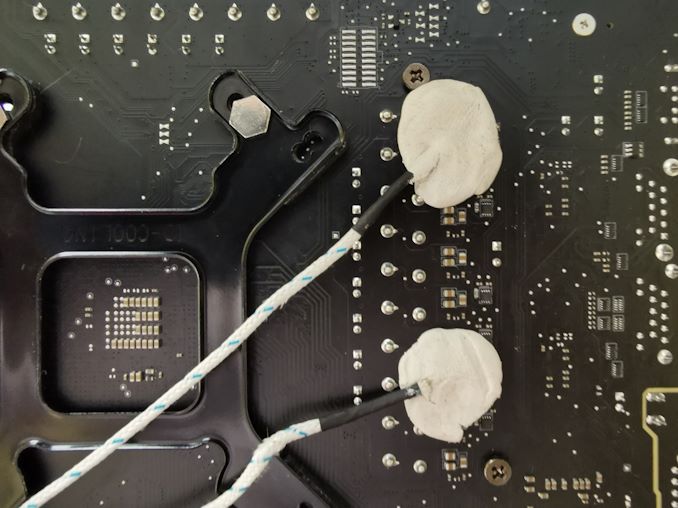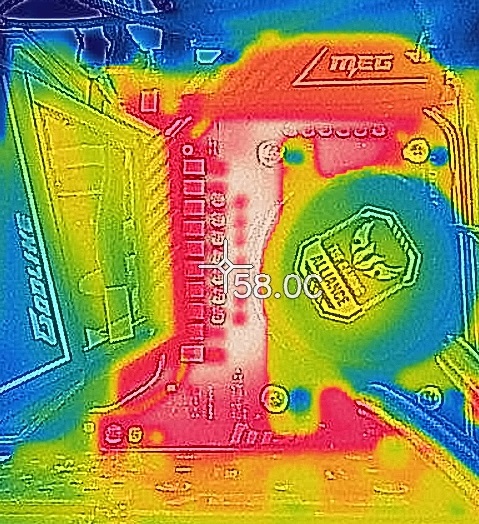The MSI MEG X570 Godlike Motherboard Review: Thor's Flagship
by Gavin Bonshor on August 28, 2019 12:00 PM EST- Posted in
- Motherboards
- AMD
- MSI
- 10G Ethernet
- Ryzen
- PCIe 4.0
- Ryzen 3000
- X570
- X570 Godlike
- MEG
Power Delivery Thermal Analysis
One of the most requested elements of our motherboard reviews revolves around the power delivery and its componentry. Aside from the quality of the components and its capability for overclocking to push out higher clock speeds which in turn improves performance, is the thermal capability of the cooling solutions implemented by manufacturers. While almost always fine for users running processors at default settings, the cooling capability of the VRMs isn't something that users should worry too much about, but for those looking to squeeze out extra performance from the CPU via overclocking, this puts extra pressure on the power delivery and in turn, generates extra heat. This is why more premium models often include heatsinks on its models with better cooling designs, heftier chunks of metal, and in some cases, even with water blocks such as the ASUS ROG Crosshair VIII Formula.

Two K-Type Thermal Probes attached to the rear of the power delivery on the MSI MEG X570 Godlike
Testing Methodology
Out method of testing out if the power delivery and its heatsink are effective at dissipating heat, is by running an intensely heavy CPU workload for a prolonged method of time. We apply an overclock which is deemed safe and at the maximum that the silicon on our AMD Ryzen 7 3700X processor allows. We then run the Prime95 with AVX2 enabled under a torture test for an hour at the maximum stable overclock we can which puts insane pressure on the processor. We collect our data via three different methods which include the following:
- Taking a thermal image from a birds-eye view after an hour with a Flir Pro thermal imaging camera
- Securing two probes on to the rear of the PCB, right underneath CPU VCore section of the power delivery for better parity in case a probe reports a faulty reading
- Taking a reading of the VRM temperature from the sensor reading within the HWInfo monitoring application
The reason for using three different methods is that some sensors can read inaccurate temperatures, which can give very erratic results for users looking to gauge whether an overclock is too much pressure for the power delivery handle. With using a probe on the rear, it can also show the efficiency of the power stages and heatsinks as a wide margin between the probe and sensor temperature can show that the heatsink is dissipating heat and that the design is working, or that the internal sensor is massively wrong. To ensure our probe was accurate prior to testing, I personally binned 10 and selected the most accurate (within 1c of the actual temperature) for better parity in our testing.
For thermal image, we use a Flir One camera as it gives a good indication of where the heat is generated around the socket area, as some designs use different configurations and an evenly spread power delivery with good components will usually generate less heat. Manufacturers who use inefficient heatsinks and cheap out on power delivery components should run hotter than those who have invested. Of course, a $700 flagship motherboard is likely to outperform a cheaper $100 model under the same testing conditions, but it is still worth testing to see which vendors are doing things correctly.
Thermal Analysis Results

We measured 58°C on PCB between the CPU socket and power delivery
The MSI MEG X570 Godlike is running a 14-phase design for the CPU VCore section. This includes an International Rectifier IR35201 running in a 7+1 configuration with seven IR3599 doublers on the rear of the PCB; the SoC section is running four phases off a single IR3599 which splits the signal into four. As far as designs go, this is MSI's best AMD power delivery that I can recall seeing, although I still find it a little odd that the SoC section is split into four, but through one IR3599 doubler in quad mode. Perhaps this will yield some benefits and gains for extreme overclockers, but it's not an issue for general users to be concerned about. The heatsink is very similar to the MSI MEG X570 Ace and uses the same design. The power delivery heatsinks are interconnected by a heat pipe which stretches around the left side of the memory slots and down into the actively cooled X570 chipset heatsink.
As we get more results, we will endeavour to update this chart when more models have been tested
Note - The ASRock B450 Gaming ITX-ac model crashed instantly every time the small FFT torture test within Prime95 was initiated. At anything on the CPU VCore above 1.35 V would result in instant instability. The Ryzen Master auto-overclocking function failed every time it tried to dial in settings, but it does however operate absolutely fine at stock, and with Precision Boost Overdrive enabled. Either the firmware is the issue, or the board just isn't capable of overclocking the Ryzen 3700X with extreme workloads with what is considered a stable overclock on the X570 chipset. We will re-test this in the future.
The power delivery on the MSI MEG X570 Godlike actually runs slightly cooler in our testing which can be explained by having a slightly better 14+4 power delivery versus the 12+2 design on the MSI MEG X570 Ace. More phases usually generate less heat overall as each phase is active for a shorter period of time, which does show in our testing. We ran our AMD Ryzen 7 3700X testbed sample at 4.1 GHz with a CPU VCore of 1.45 V which is consistent with other models we have tested to try and generate as much heat as possible. The power delivery probe output reading was 59°C after an hour of testing, while the VRM temperature sensor gave us a reading of 61°C. The MSI MEG X570 Godlike does well under our testing method and there should be no issues when overclocking the current Ryzen 3000 processors, as we found that we hit CPU thermal limitations before anything else.











116 Comments
View All Comments
inighthawki - Wednesday, August 28, 2019 - link
Depends what you're doing. The 9900K is already, at stock, anywhere from 5-10% better single core perf than AMD, and also overclocks much higher. So if you're willing to accept the additional power draw and thermal output and your goal is raw single core performance, then absolutely.If you're working in highly multithreaded scenarios then the new 3900 and 3950 chips are clearly a much superior choice.
Most people who are willing to spend this much money and OC their parts are also generally not too concerned with future proofing their systems. If you can afford (and are willing to spend) $700 on a motherboard, it stands to reason that money is not much of a concern and they probably don't care about having to buy a new motherboard for a new socket in a couple years.
StevoLincolnite - Wednesday, August 28, 2019 - link
The 9900K is only an 8-core CPU though........ AMD can trounce it with it's higher core-count parts in multi-threaded scenarios.yetanotherhuman - Thursday, August 29, 2019 - link
He does say that, and you know he hasn't edited his post, because it's not possible :DQasar - Thursday, August 29, 2019 - link
but why buy a 9900k when you can get the 3900X for the same price, use less power over all, pretty much the same IPC, and get 4 more cores on top of that ?? who cares if the 9900K can hit 5gz?? clock speed isnt everything, the Athlon 64 proved that way back when vs the P4. besides.. what if ryzen 3000 series did hit the same clocks as intel does, that would make intel's cpus look even worseinighthawki - Thursday, August 29, 2019 - link
Because the 9900K still edges out the 3900 (and presumably the 3950) in single threaded performance. Some people care about that more than having more cores.AshlayW - Thursday, August 29, 2019 - link
wow 5-10%, now tell me where that actually matters over the disadvantages of owning the 9900K vs Ryzen 3000.Oliseo - Thursday, August 29, 2019 - link
"wow 5-10%, now tell me where that actually matters over the disadvantages of owning the 9900K vs Ryzen 3000. "Compiling software for one. By it's very nature it's single threaded.
Likewise DAWs also prefer high frequency high IPC cores rather than multiple lower specced lower frequencey cores.
When you route your channels through an effects bus, that effects bus is allocated a core. It CANNOT be spread over multiple threads.
Asking silly questions like that only demonstrate your own ignorance, where you highlight you don't actually know what it is you're talking about.
It's okay though, we were all young once. I'd recommend in future putting aside your brand loyality though. It's not worth your effort, they aren't loyal to you in any shape or form.
peevee - Friday, August 30, 2019 - link
"Compiling software for one. By it's very nature it's single threaded."Seriously? You obviously missed an option or two.
29a - Friday, August 30, 2019 - link
I'm not disagreeing with you but those last two paragraphs were unnecessary. You'll catch more flies with honey than vinegar.Bus3rr0r - Friday, August 30, 2019 - link
Maybe if you are writing single module programs in your mom's basement a singel core is fine.Most devleopment projects of even relatively small projects have hundreds with larger projects running into thousands of modules. It is not only common practise to compile modules in parallel butit woudl be ridiculous not to.
The reality is there are very few applications that cannot take advantage of multi-core.
You critise others for their ignorance while demonstrating your ignorance, remarkable.